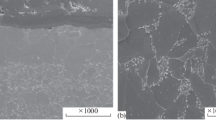Abstract
A failure analysis has been conducted on board a cargo ship to assess the extent of corrosion damage. The damage was classified as unusual by the ship owner since the material, an organic fat (namely tallow), was usually loaded into stainless steels on board tanks without any noticeable corrosion problems. The corrosion phenomenon was classified, by the technical crew, as pitting on the bottom of two tanks, particularly the 6p (port tank) and the 6s (starboard tank). The pitting was defined as anomalous since only two tanks were affected and a total of five tanks were made of same stainless steels and loaded with same organic fat mixture. Corrosion pits were found during final inspection by the captain, following load discharge and tanks cleaning operations. The initial inspection was carried out while the cargo ship was harboured at Algeciras (Spain). Because of the observations, the ship remained in harbour for 3 days awaiting inspection by qualified technicians to evaluate the possibility of resuming navigation. The cargo ship was then inspected by one of the authors in collaboration with two metallurgists acting as consultants to the ship owner. The purpose of the inspection was to investigate on damage phenomena, to evaluate the integrity of cargo structures and to decide on two possible options: resuming navigation or immediately ordering a very expensive stop for urgent maintenance. This paper was structured to show documentation (some details have been omitted for propriety reasons) and visual inspection results used to establish failure mechanisms and probable failure-root causes. These results enabled a decision for the cargo ship to resume travel to next dockyard for maintenance operations.



Similar content being viewed by others
Notes
To ensure corrosion resistance, that is, the formation of the passivation layer protecting against the external environment, the chromium content in the steel must not be below 10.5%.
Corrosion phenomena can be divided into two main categories: (a) dry corrosion and (b) wet corrosion. Dry corrosion involves a deterioration of the surface of the part in question due to the reaction between the metal and oxygen in the atmosphere. This reaction (favored by high temperatures, hence the term hot oxidation is also used) leads to the formation of a metallic oxide, according to the generic reaction Me + ½O2 → MeO, which is readily deteriorable. The phenomenon proceeds gradually as the metallic oxide continues to form and detach from the surface.
Normally, 95% of the time corrosion (including the case described in this report) falls into the second group. Wet corrosion occurs when the metallic material comes into contact with an environment containing moisture, and the phenomenon that occurs is electrochemical in nature, that is, typical of galvanic systems. In a galvanic system, one “part” of the system becomes an anode (i.e., the metal gives off electrons and Me+ ions form) and are thus called anode areas, while another “part” takes the behavior of a cathode, that is, acts as a catalyst by triggering, without taking part, a reaction involving the reduction of the oxygen contained in the electrolyte (e.g., the reaction O2 + 2H2O + 4e− → 4OH−). The corrosion products that form, such as the Me+ metal ions, react with the OH− ions, give rise to soluble and deteriorable corrosion products.
Often the effective damage caused cannot be quantified, as the surface shows just a small point of corrosion, underneath which, hidden, lies a much larger crater.
For example, stainless steel is normally resistant in an aqueous solution of NaCl; however, if the salinity increases locally, the steel becomes sensitive to its aggressive action. This is the typical phenomenon that causes the formation of pits on the bottom of a cooking pot made from austenitic stainless steel (renowned as being highly resistant to salt water) when coarse salt is placed in cold water: this deposits undissolved on the bottom of the pot. To avoid this, the salt simply needs to be added to the water in the pot when this is already boiling, so that the salt dissolves instantly before it deposits on the bottom.
The creation of anode and cathode areas often depends on the phenomenon of differential aeration. Due to variable concentrations of oxygen, for example as in the case of droplets of water on a metal, oxygen-rich cathode areas are formed (areas surrounding the droplet), together with a very small anode area concentrated in the oxygen-lacking center of the droplet (due to the poor diffusivity of oxygen inside the droplet). The evolution of the phenomenon is not different from the case of galvanic corrosion; a moving charge is created from the surface of the metal underneath the droplet toward the surface of the latter. This is where the cathodic reaction for the reduction of oxygen occurs, with the formation of OH− ions, which are repelled toward the center of the droplet. The conclusion of the process involves, as highlighted, the precipitation of different types of oxide-hydroxide aggregates.
Depassivation refers to the breakage of the chromium oxide film due to the reaction between the BHT and oxygen.
This phenomenon is typical of the autocatalysis process that is always present in crevice corrosion attacks. The specific case in question involves what can more precisely be called under-deposit corrosion. This is a process that, while the surrounding conditions remain the same, continues unstoppably.
References
BS 6744: Stainless steel bars for the reinforcement of and use in concrete—Requirement and test methods, British Standard Institution, s.l., 2001
ASTM A380: Standard practice for cleaning, descaling and passivation of stainless steel, parts, equipments and systems, 2006
ASTM A967: Standard specification for chemical passivation treatments for stainless steel parts, 2005
Author information
Authors and Affiliations
Corresponding author
Rights and permissions
About this article
Cite this article
D’Errico, F., Boniardi, M. Unexpected Corrosion Problems by Organic Fat Charged in Loading Tanks of a Cargo Ship. J Fail. Anal. and Preven. 9, 297–304 (2009). https://doi.org/10.1007/s11668-009-9269-3
Received:
Revised:
Accepted:
Published:
Issue Date:
DOI: https://doi.org/10.1007/s11668-009-9269-3




